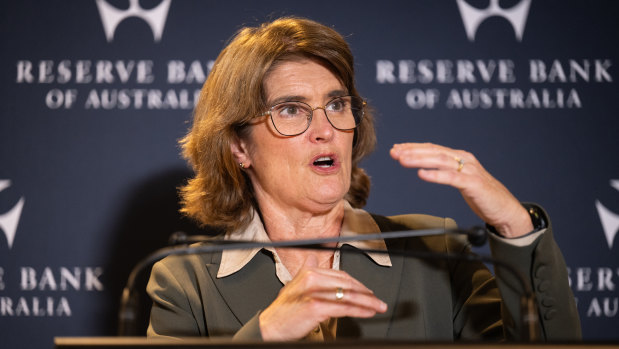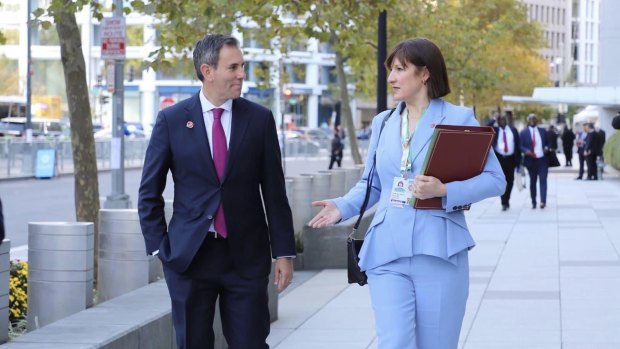By Shane Wright
COVID-19 has cost the Reserve Bank more than $51 billion, punching another $4.2 billion hole in its bottom line over the past 12 months and in effect preventing it from supporting the federal budget for years to come.
As the federal government received the independent report it commissioned into the handling of the pandemic, the RBA’s annual report revealed the extent of red ink across its books left by the extraordinary measures it deployed during COVID-19.

RBA governor Michele Bullock has revealed the bank made a $4.2 billion loss last financial year. It has now lost more than $51 billion since the Covid pandemic.Credit: Louie Douvis
During 2023-24, Reserve Bank governor Michele Bullock said the institution had suffered a $4.2 billion operating loss. It was the fourth consecutive loss made by the bank and follows shortfalls of $6 billion in 2022-23, a record $36.7 billion in 2021-22 and $4.3 billion in 2020-21.
Total accumulated losses have now reached $34 billion, all of which have occurred over the past three years. The bank now has negative equity of $20.4 billion.
The losses are largely due to the $330 billion of government bonds the RBA bought during the pandemic to keep interest rates on official debt at ultra-low levels. Since then, interest rates have climbed, hitting the bank’s bottom line.
“The loss reflects the fact that returns on most of our assets were fixed at the low rates prevailing in 2020 and 2021, but the cost of our liabilities rose with the cash rate target,” Bullock said.
The bank has completed a series of internal reviews into the various measures in place during the pandemic. On Friday, the government received a report it commissioned into the health, economic and government responses to COVID-19.
Headed by former senior public servant Robyn Kruk plus economist Angela Jackson and infectious diseases expert Professor Catherine Bennett, the report is expected to be made public soon.
While higher interest rates have hurt the bank’s finances, it made $1.6 billion from the global lift in gold prices over the past year. The bank holds about 6400 bars of the precious metal, now worth $9 billion, in the vaults of the Bank of England in London.
Before the pandemic, the federal government received dividend payments from the bank, which helped improve its budget. In 2020-21, it paid $2.7 billion to the then-Morrison government.
But Bullock noted the bank’s board believed it was important to restore the institution’s finances, which were unlikely to be fully repaired for another decade.
She said the board had told the government of its “strong expectation” that the bank’s future earnings be retained to offset the losses accumulated over recent years.
“Negative equity does not affect our operations or ability to perform our policy functions, but the Reserve Bank board considers it important that the RBA’s capital be restored over time,” she said.
The absence of RBA dividends has been baked into the budget, which is in a stronger position than expected a quarter of the way into the financial year.

Treasurer Jim Chalmers with Britain’s Chancellor of the Exchequer Rachel Reeves on the sidelines of this week’s IMF meetings in Washington.
But figures released by the Finance Department on Friday show these signs of improvement are being carried by ordinary taxpayers.
In May, Treasurer Jim Chalmers forecast a total budget deficit for the current financial year of $28.3 billion.
On a pro rata basis, it was expected to show a deficit of $17.8 billion to the end of September. Instead, Friday’s figures showed a deficit of $14.2 billion for the first three months of 2024-25.
Total revenue was $6.7 billion better than forecast.
Much of this was due to personal income tax collections from ordinary workers, which were $2 billion more than expectations. Superannuation taxes were $900 million ahead of forecasts, as was GST.
Company tax collections, however, were almost $1 billion short of forecasts. One of the biggest shortfalls is for petroleum resource rent tax, with less than $300 million collected so far this year, rather than the $1 billion predicted in May.
Total spending is $3.2 billion higher than expected, largely due to social security payments.
In Washington for this week’s meeting of the International Monetary Fund, Chalmers said he remained committed to using the budget to put downward pressure on inflation.
“My job is to focus on what I can control – delivering two surpluses for the first time in almost two decades, showing spending restraint, finding savings in the budget,” he told CNBC.
The report revealed the bank employed an extra 199 staff during the year, an increase of 12.6 per cent, to 1774. That followed a 147 jump in the number of employees in 2022-23.
Bullock’s base pay reached $990,206, just 1.6 per cent up on the final full-year payment to previous governor Philip Lowe. Bullock’s total remuneration, including superannuation and long service leave, reached $1.2 million.
Cut through the noise of federal politics with news, views and expert analysis. Subscribers can sign up to our weekly Inside Politics newsletter.